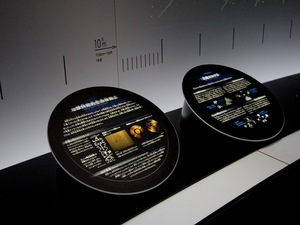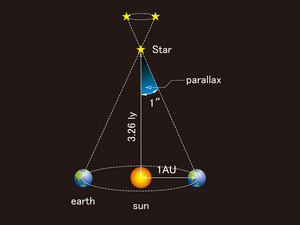Nagoya City Science Museum
TOP > Exhibition Guide > Floor Map> Measuring / Exploring the Universe
Measuring / Exploring the Universe



Purpose of Exhibition
Come into this gallery from the north entrance and walk clockwise around the perimeter, looking at the displays, you will travel from our earth to the end of the Universe. The outer ring is lined with various astronomical objects and cosmic events in order. This exhibit is based on the idea of Powers of Ten, where the scale increases tenfold each time.
This exhibit will show you a summary of the units of length and distance measurements in the Universe, which appear on the Powers of Ten scales, display boards and panels. It also features planetary systems other than the solar system and the search for extraterrestrial intelligence.
Additional Knowledge
[Ambiguity of Distance in the Universe]
With the advancement of science and technology, you might think that the distances to celestial objects have been measured to a full extent. No, this is not the case.
To measure the distance to a star, we use triangulation with the baseline of 300 million km, which is made by the earth’s orbit around the sun. Still, the stellar distances are so great that even for the nearest star, Alpha Centauri, the angle to determine its distance is less than 1" (arcsecond), which is one 3600th of a degree. For more remote stars, we have to measure much smaller angles, whereas the observation error due to atmospheric turbulence is 60 times larger (i.e. to the order of one minute angle). This makes it very difficult to determine the distance with accuracy, no matter how highly the observation technology develops and advances.
Artificial satellites are currently available to take measurements from space, where there is no atmospheric turbulence; yet they can only provide accurate observations of stars within 400 light years or less. Many stars are visible to the naked eye at distances farther than 400 light years. For example, Deneb in Cygnus, one of the Summer Triangle, is 1424 light years away. The two first-magnitude stars in Orion, Betelgeuse and Rigel, are also 497 and 863 light-years away, respectively. So, in addition to triangulation, we began to use another method of estimating a star’s true brightness from its temperature and color (namely, absolute magnitude) to determine the distance. As a result, the distances of stars, which are supposed to be constant for everyone, differ depending on the approach and interpretation one adopted.
As such, different books often list different distances to a star. This is not just a problem with stars. The famous Andromeda Galaxy was estimated to be 2.3 million light years away in 2010, but recent studies have shown that it is much larger.
The diameter of the galaxy itself is determined from its apparent size and distance, and if the distance is farther, then the size of the galaxy is actually larger than previously calculated.
There is still a lot of ambiguities in the distances to celestial objects and in the size and actual brightness derived from them, because the Universe is so large, even now that measurement technology has improved so much.
This page was last edited on 30 June 2022.
Article by Astronomy Section
